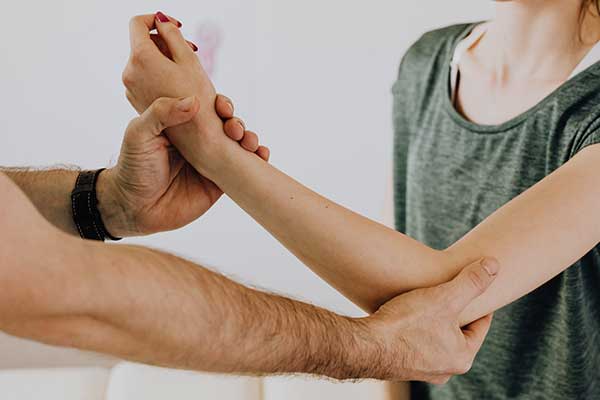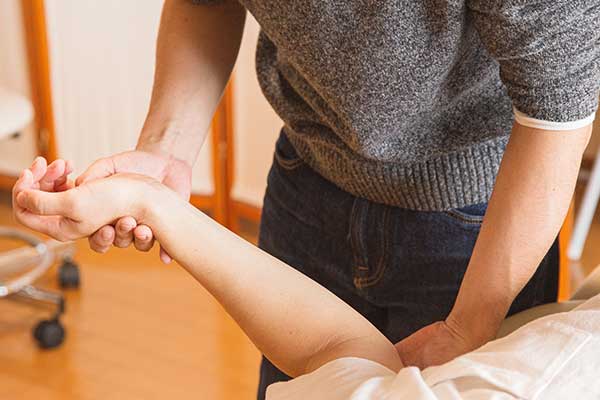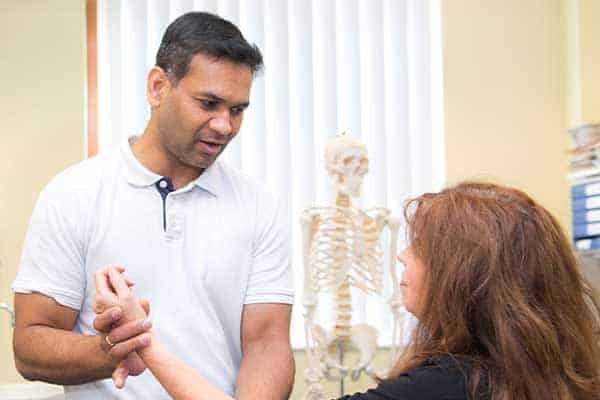Golfer’s elbow is a condition that causes pain on the inside of your elbow.
What causes golfer’s elbow?
Despite the name, golfer’s elbow does not only affect people who play golf. It can affect anyone who puts strain on their elbow or forearm muscles through repetitive activity.
The condition affects the tendons and muscles of the forearm on the inside of your elbow. These tissues are involved in bending your wrist and moving your fingers to make a fist. They also help you to grip and stabilise your wrist when you move your hand. They can be overstressed when you increase the amount of gripping, lifting or typing you do, or when you allow too little time between activities for them to recover.
What are the symptoms of golfer’s elbow?
For most people:
- You experience pain on the inside of your elbow.
- The pain increases when gripping or lifting objects, or twisting open jars and door handles.
- You experience pain and stiffness when bending and straightening your elbow and/or wrist.
- The bony parts on the inside of your elbow are tender or painful to touch.
For some people:
- You may also experience the pain in your forearm, on the palm side.
- Your grip might feel weak, as though you are about to drop what you are holding.
How is golfer’s elbow diagnosed?
Your doctor can usually diagnose golfer’s elbow by talking to you about your symptoms and your history, and by examining you. Investigations are not usually needed.
What are the treatment options for golfer’s elbow?
Self-management is often all that is needed to treat golfer’s elbow.
Try to manage the pain during the first few days and give your tissues time to recover. Identify the activities that make the pain worse and if possible stop them for a short period. If not, try to reduce them, modify the way you do them, or factor in more rest and recovery time between them.
You could try anti-inflammatory painkillers such as Ibuprofen. Some anti-inflammatory painkillers also come as creams or gels, which you can rub over your painful elbow. These tend to produce fewer side effects than those taken by mouth. If you cannot take anti-inflammatory painkillers, or if you have been advised not to take these during a particular phase of the healing process, other painkillers such as paracetamol, with or without codeine added, may be helpful. Ask your doctor or pharmacist for advice.
In certain cases, you may also benefit from an elbow clasp/brace. This is worn on the forearm just below the elbow joint and can help to relieve pain by reducing the load on the affected tissues. Your doctor may recommend this, or you could ask your pharmacist for advice.
When resting, try to keep your elbow and forearm above the level of your heart. This can help to relieve pain. Try not to let your arm hang down by your side.
You could also put an ice pack on your inner elbow and forearm area for 10-15 minutes, every three hours. (Do not put ice directly next to skin as it may cause ice burn. Wrap it in a damp tea towel. Remove the pack if irritation increases. Allow the area to return to normal temperature before reapplying the ice.)
Even while resting your arm, you should keep generally active. As soon as the pain has settled down, you should start exercises to restore strength and mobility in your muscles and tendons again. These should build up gradually to your normal level of activity. Work your muscles and tendons hard, but avoid any exercises that cause lingering pain.
You may be recommended physiotherapy or other forms of manual therapy.
What is the prognosis (outlook) for golfer’s elbow?
Pain from golfer’s elbow will usually show significant improvement within 4-6 weeks and the symptoms should be minimal after 6-12 weeks. However, be aware that elbow tendon conditions can take between 6-24 months to fully resolve themselves.
How can I prevent recurrence of golfer’s elbow?
It is important not to overdo your recovery exercises or to return to sports too early.
However, it is also unwise to avoid exercise, as this can lead to further problems. Tendon problems have been linked to factors such as smoking, obesity, diet, high cholesterol levels and diabetes. Keeping healthy and active is always important.
If your condition relates to a work-based activity, you are advised to speak to your employer or occupational health representative about altering the tasks you perform. There are particular changes you can make to the way you use a mouse and keyboard.
Whether your condition is work, sport or home related, there are changes you can make yourself that may help to avoid another episode.
Try to factor in more time doing something else between bouts of repetitive activity. Think about your posture and, in the case of a sport like golf, your grip and technique.
Continue with your exercises to restore, maintain and improve strength and mobility.
Recommended exercises (click to expand):
Isometric wrist flexion
- Sit alongside a table with your affected forearm resting on the surface and your hand outstretched, palm-up.
- Bring your other hand across to place it on the palm of your affected hand.
- While resisting the movement with your unaffected hand, try to lift your affected hand and wrist upwards, keeping your forearm in contact with the table.
- Hold this position, then relax and repeat.
Eccentric wrist flexion
- Sit at a table with your affected forearm resting on the surface and your hand over the edge, holding a moderate weight (such as a tin of beans) with the palm facing upwards.
- Use your other hand to lift your affected hand and wrist upwards as close to 90 degrees as is comfortable, keeping your forearm in contact with the table.
- Remove your supporting hand and slowly lower your affected hand back down to the starting position by itself.
- Relax and repeat.
Weighted wrist flexion
- Sit at a table with your affected elbow resting on the surface and your hand over the edge, holding a moderate weight (such as a tin of beans) with the palm facing upwards.
- (You can also perform this exercise with your elbow resting on your knee instead of a table.)
- Allow your wrist to relax down in its natural position, then bend your hand upwards until your wrist is fully flexed.
- Return your hand and wrist to the starting position, then repeat.
Bicep curl
- Sit in an upright chair with a moderate weight (such as a tin of beans) held in your affected hand.
- Let your arm and hand extend down to your side, with your palm facing forwards.
- Bend your forearm forwards and up, bringing the weight towards your shoulder and keeping your elbow at your side.
- Lower the weight back down, controlling the movement of your arm until it is straight again.
- Repeat.

How to get referred
Find out how to get referred to Practice Plus Group MSK & Diagnostics for NHS treatment.




